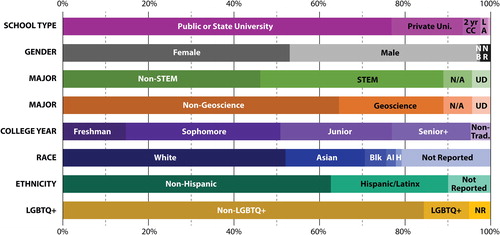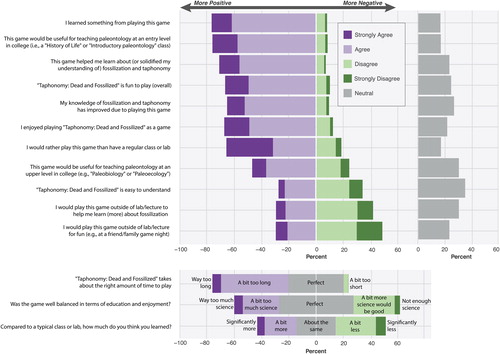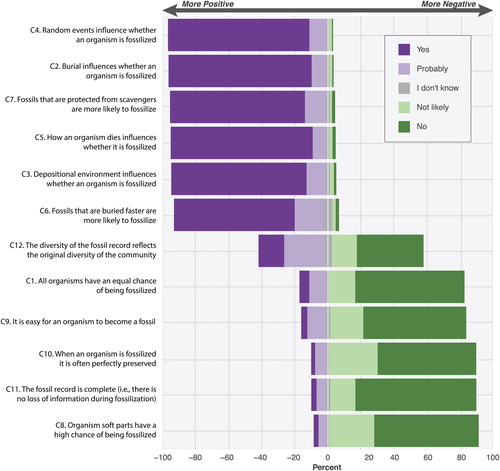Figures & data
Figure 1. Schematic of the “Taphonomy: Dead and Fossilized” board game and associated material, i.e., cards, GPS trackers, tokens, game board, game pieces, and organisms.

Figure 3. Summary of the test population demographics; full demographic breakdown of all 760 participants listed in the supplemental data. School Type: 76.7% Public or State Universities, 16.6% Private Universities, 4.1% two-year community colleges (2 yr CC), and 1.8% Liberal Arts colleges (LA). Gender: 53.0% female students, 43.9% male students, 0.7% non-binary students (NB), and 2.4% other/prefer not to say (NR). Major: 45.9% non-STEM majors, 42.9% STEM majors, 4.5% undeclared majors (UD), and 6.7% were not undergraduates (N/A); 24.5% were geoscience majors and 64.3% were non geoscience majors. College Year: 14.5% Freshmen (first year), 36.4% Sophomore (second year), 26.1% Junior (third year), and 18.4% Senior (fourth year or higher) students; 4.6% reported being a nontraditional student or not an undergraduate (non-Trad.). Race: 52.1% White, 18.5% Asian, 5.2% Black (Blk), 1.3% American Indian or Alaskan Native (AI), 2.1% Hawaiian or Pacific Islander (H), and 20.8% did not report their race. Ethnicity: 62.5% of students are not Hispanic, 27.5% of students are Hispanic or Latinx, and 10.0% did not report their ethnicity. LGBTQ+: 9.7% identify as LGBTQ+ (lesbian, gay, bisexual, transgender, queer and others), 85.7% did not, and 4.6% preferred not to say (NR).

Figure 4. Diverging bar charts of student survey data with a focus on focuses on the players’ opinions of “Taphonomy: Dead and Fossilized” as an educational board game.

Figure 5. Diverging bar charts of student survey data with a focus on the knowledge assessments of game players following game play. Question numbers (i.e., C1-C12) correspond to the survey results in supplementary data.

Figure 6. Diverging bar charts of teacher survey data, including both professors and teaching assistants. Specifically, the teachers’ opinions of “Taphonomy: Dead and Fossilized” as a board game and educational tool.

Table 1. Student comments about the game and educational gains, see supplementary data for a complete list of student comments.
Table 2. Teacher (professor and teaching assistant) comments about the game, see supplementary data for a complete list of teacher comments.
Table 3. Standardized residual results for Question B1: “Taphonomy: Dead and Fossilized is fun to play (overall).” Positive values indicate positive association, negative values indicate negative association; merged cells indicate combined groups of similar responses that were analyzed together (e.g., strongly agree + agree versus disagree + strongly disagree).
Table 4. Standardized residual results for Question B6: “My knowledge of fossilization and taphonomy has improved due to playing this game.” Positive values indicate positive association, negative values indicate negative association.
Table 5. Standardized residual results for Question A3: “Compared to a typical class or lab, how much do you think you learned?.” Positive values indicate positive association, negative values indicate negative association.
Table 6. Standardized residual results for Question B11: “This game would be useful for teaching paleo at an entry level at a college or university.” Positive values indicate positive association, negative values indicate negative association; merged cells indicate combined groups of similar responses that were analyzed together.
Table 7. Standardized residual results for Question B12: “This game would be useful for teaching paleo at an upper level at a college or university.” Positive values indicate positive association, negative values indicate negative association.
Table 8. Standardized residual results for Question A2: “Was the game well balanced in terms of education and enjoyment?.” Positive values indicate positive association, negative values indicate negative association.
Table 9. Standardized residual results for Question B3: ““Taphonomy: Dead and Fossilized” is easy to understand.” Positive values indicate positive association, negative values indicate negative association; merged cells indicate combined groups of similar responses that were analyzed together.

